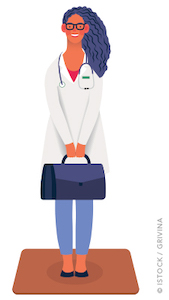
Fam Pract Manag. 2021;28(3):35
BRING THESE TWO ITEMS TO HOME HEALTH VISITS

As a home-based primary care physician, I see medically complex older and disabled adults in their homes. Two purchases have helped me feel more comfortable and confident doing this rewarding work.
The first is a portable place to sit. I have found that a plastic stepstool is the right height and level of support. I can use my tablet on my lap for documentation while making sure I don't sit in something I don't want to take home with me. It's also easy to carry and store in the backseat of my car.
The second item is a backpack-style diaper bag. It has many pockets to keep my small items contained and accessible, and I can wipe it down when needed. To leave my hands free, I keep it on my back until I need it. Newer diaper bags are gender-neutral and understated.
PAIR MEDICAL ASSISTANTS WITH SPECIFIC PHYSICIANS
To improve productivity and patient care, practices should pair medical assistants (MAs) with specific physicians rather than rotating them.
NorthShore University Health-System in Illinois matched MAs with physicians based on their ranked choices and had each pair complete standard forms to establish preferred workflows, task delegation, communication patterns, and schedule management. Physicians found they were gradually able to delegate more tasks to their assigned MA. After six months, relative value units per physician increased by 11% over the previous six months and A1C values, cervical cancer screening rates, and depression screening rates also improved. According to the study authors, physicians reported increased satisfaction and “an enhanced sense of personal accountability and investment in success by the MA often lacking in the rotating staff model.”
EXPAND BUPRENORPHINE TREATMENT VIA TELEHEALTH
The Drug Enforcement Agency temporarily relaxed restrictions on prescribing buprenorphine via telehealth and telephone last year because of the COVID-19 pandemic.1 The team at our federally qualified health center has since developed protocols — some of which may be applicable to other practice settings — for connecting patients with opioid use disorder (OUD) to telehealth visits and following up:
If patients contacted us after hours, the on-call clinician called them back, completed a telehealth visit, and called in the buprenorphine prescription to the nearest pharmacy so the patients could initiate treatment as soon as possible. The next day, office staff would register the patients and try to schedule a follow-up appointment for one or two days later.
We created “on demand” telehealth OUD slots using our existing system for same-day or sick-visit appointments.
A certified addiction registered nurse provided triage and counseling to these patients (this role could also be filled by a registered nurse, licensed practical nurse, medical assistant, or licensed clinical social worker with an interest in addiction care).
We developed a network for follow-up OUD care, including behavioral health referrals.
We partnered with pharmacies to maintain buprenorphine stock and make sure uninsured patients had access to it.
Two principles guided our work: minimize intake time for new patients with OUD and ensure a positive experience that encouraged patients to remain in treatment.
The telehealth program has been a silver lining of the pandemic, removing transportation challenges for our patients and making it easier for them to fit visits into their work schedules. The follow-up rate for our OUD telehealth patients was 80% in the first 30 days, which is superior to rates for in-person visits in some studies.2 Hopefully, this regulatory flexibility will continue after the pandemic.
